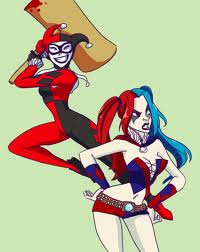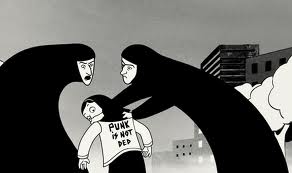Serendip is an independent site partnering with faculty at multiple colleges and universities around the world. Happy exploring!
From Harley Quinn to Marjane Satrapi: How Genre and Institutional Tropes Affect The Male and Female Gaze

In the summer of 2011, one of the world’s biggest comic distributors, DC, announced that it would be re-launching many of its most popular titles with new storylines and re-imagined characters. Superhero fans of all genders rejoiced until they saw the new titles and realized that many of DC’s female characters had been rendered flatter, more sexually appealing, and less dynamic than ever before. Female fans the world over began to press, at comic conventions and on the internet, for answers from DC as to why they had decided to leave 50% of the world’s population behind as they modernized their books. They were met with a variety of responses, many of which added up to a simple “We write for men.” Though this sentiment is nothing new, and female comic characters have always been rendered to suit the male gaze, it is problematic when taken in the context of a purported modernization and exceptionally problematic when one considers the extreme leaps in sexualization that many of DC’s female characters have endured in the context of the recent reboot.

For example, the above image of the Batman villainess Harley Quinn shows her previous design in the background, and her current design in the foreground. While her image has always been sexy, Quinn is now costumed in such a way as to be good for nothing but sex, and she is very far removed from her context as a harlequin. Other DC women, such as Catwoman and Poison Ivy (who has sometimes been written as Harley Quinn’s lover) have undergone similar “reboots”, as has DC’s staff, which has gone from over 10% female to a scant 1%.
So what does this have to do with alternative comics and graphic novels such as Marjane Satrapi’s “Persepolis?” And what does it have to do with the inclusion of graphic forms in an academic setting?

During our class discussion of Persepolis, we touched upon the idea that “Persepolis” is not a new story for a college course of feminist perspectives. It is the story of a headstrong, mouthy, brave, and smart young woman. It is exactly the kind of story that has traditionally been read and relished in feminist circles. While I do think that this is true, I am left wondering if we perhaps failed to consider what stories and images such as Satrapi’s mean when they are placed into the larger context of women in comics.
While it’s easy for me to agree that, when we focus on Satrapi’s voice instead of the setting of war torn Iran, Satrapi’s story is one that is often told in academic settings, it is interesting to note that Satrapi’s story is not one that is traditionally allowed into the comic genre. Perhaps then, it is possible to posit that the inclusion of her voice, and more like hers, highlights the question of how women are included in comics and how they might begin to be included in more acceptable ways. Furthermore, the inclusion of “Persepolis” and other graphic novels in an academic setting highlights how we may begin to reimagine what counts as canon worthy literature.
Satrapi’s story breaks new ground in the comic genre for several reasons. The first is the fact that her story is female written, female drawn, and female directed. Though a quick google search nets hundreds of female comic creators over time, Satrapi stands out as a writer who is breaking the tropes of the genre by drawing upon a female experience that is without western body objectification by its nature. Set in a place where even a few strands of hair are considered dangerously provocative, ‘Persepolis” naturally subverts the idea that a woman’s story in graphic form is most compelling when it caters to the male gaze. It sets up a tension between male oppressed female sexuality and male directed female sexuality, and then allows us to understand how they may be exactly the same thing playing out in two different ways. Just as Harley Quinn’s colorful new getup limits her ability to pursue her dream of combat and evil trickery by limiting her potential range of motion, Satrapi’s clothing limits her ability to draw, to run, and to express herself. However there is a crucial difference when it comes to each character’s reaction to their costumes. While Quinn is written into adoring her lack of covering and even exploiting her own overt sexual allure, Satrapi explores her frustration at not being able to decide for herself what is and isn’t acceptable.
The question of acceptability is also what is at stake in the controversy over DC’s female characters. Fans are asking for female characters to be accepted without the perpetual burden of being sexual objects, and DC is responding by refusing to canonize characters who are not overtly sexual. Similarly, alternative comics such as “Persepolis” are re-categorized as graphic novels and are allowed into academic settings only when they take on the voices and stories that are considered properly academic. When left unquestioned, these parallel canons are only serving to reify the existing power structures that allow some voices through, while others are ignored.
However, these initial crossings of some new voices into previously impenetrable circles could be exactly the push that both institutions need. If more voices like Satrapi’s can make onto the shelves of comic book stores, and get more women into the shop, then it is possible to imagine a future for the comic genre that includes strong female characters in mainstream superhero settings. Likewise, as graphic genres become more acceptable in academic settings, then it may be possible to allow for an even broader scope of voices there as well. This may be a long way off, as the mainstream comic market is still very male dominated, and academic institutions are still much more likely to include particular voices, but a long way off does not mean that it is impossible.
Further Reading:
http://twilightedge.tumblr.com/post/11674689182/the-new-harley-design-can-suck-it-bring-back-the
http://www.guardian.co.uk/books/2011/aug/01/dc-comics-women-writers-creators
http://www.comicbookgrrrl.com/2011/07/24/women-in-comics-the-new-52-and-the-batgirl-of-san-diego/
http://womenincomics.wikia.com/wiki/Women_In_Comics_Wiki
http://mssnarky.wordpress.com/2011/09/24/a-response-from-a-female-comic-book-fan/



Comments
Poison Ivy sometimes written
Poison Ivy sometimes written as Harley Quinn's lover?
Someone's been in the fanfics again!
Batwoman does in fact have
Batwoman does in fact have her own title now! Wonder Woman's new book seems pretty good so far as well, though I haven't picked it up. DC Women Kicking Ass is a Tumblr that posts about pretty much anything related to DC's women, from female friendships to minor female characters to female readership and representation, if that peaks your interest at all.
Something I forgot to add that I feel would be really interesting to talk about (comic readers probably already know what it is, others less familiar with the medium maybe not): Women in Refrigerators.
A quick explanation for the less-familiar: Women in Refrigerators is a term coined to describe the way comics (I believe explicitly American comic books, but I don't think it'd be that difficult to broaden it) treat women as accessories to male characters, specifically as objects to be destroyed/hurt/brainwashed/turned evil to incite an emotional response from them, and often with little follow-through and very gruesomely. The term is named for the death of Alex DeWitt (Green Lantern Kyle Rayner's girlfriend), who was killed by Major Force (villain) and then stuffed into a fridge in her own home.
Canon-worthy comics?
S.Yaeger--
I think you are doing/saying something important here, in insisting that the academic study of comics needs to acknowledge the history of the genre, and that feminist studies courses, in particular, need to consider the historical range of representation of women in comic form. Persepolis doesn't stand alone, in other words, and it doesn't stand only in the lineage--Tintin, Maus, etc.--that Satrapi has identified, but rather in clear juxtaposition with--and as clear counter-weight to-- figures such as the re-made Harley Quinn.
Your identification of "parallel canons" that only "reify the existing power structures that allow some voices through, while others are ignored" is significant.
So, help me out here: let's re-write the canon. What comics should we be looking @, to contextualize what Satrapi has done in terms of including women in comics? "What counts as canon worthy literature"? What texts "break the tropes of the genre," in ways that are worth our studying them? (I note amophrast's recommendation, here, of the new, kick-ass Batwoman.) What else do we need to read, in order "to imagine a future for the comic genre that includes strong female characters in mainstream superhero settings"? In order to bring "an even broader scope of voices" (and body forms?) into academic settings?
Re: DC reboots
Other cringe-worthy reboots: see Starfire's character, who has changed from mostly heteroromantic asexual to desiring meaningless sex.
ON THE OTHER HAND: check out Batwoman. The style is absolutely beautiful, she's a fantastic character (and pretty new, too), and is a very kick-ass lesbian.
I read that about both
I read that about both Starfire and Batwoman. I'll definitely check out Batwoman. Does she have her own title now?
(late response and I've
(late response and I've already talked to you about this, but for the consistency of the forum)
Yes she does!! She has her own title and it's awesome.